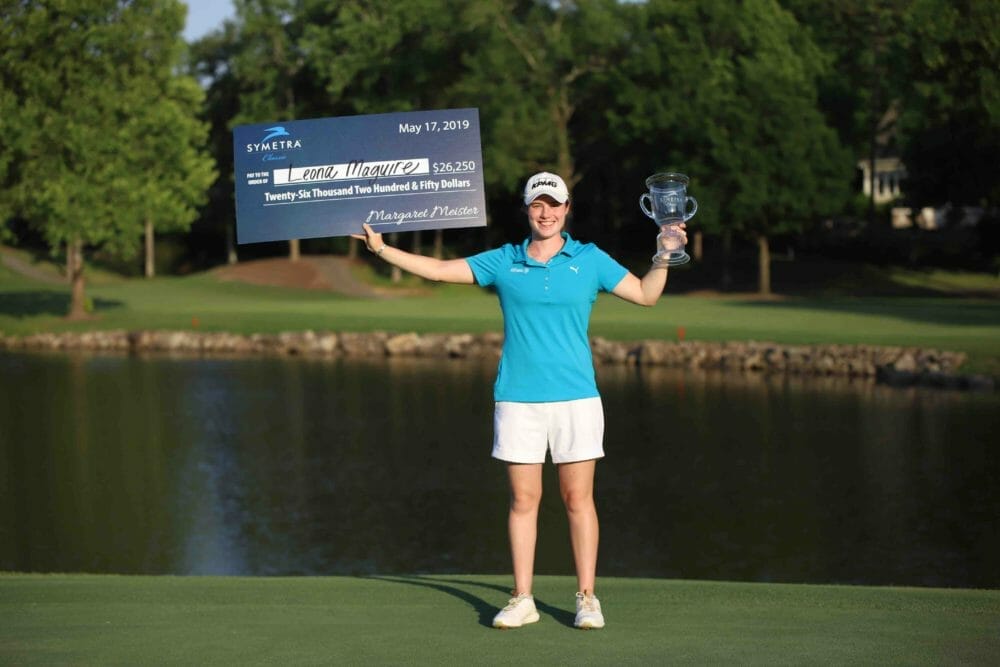The ILGU High Performance system is just over ten years old and is now set to reap the fruits of a decade of investment in developing new talent for the women’s game.
That is the view of Sinead Heraty, Chief Executive Officer of the ILGU who believes that Leona Maguire and Stephanie Meadow will soon be followed into the ranks of LPGA Tour players by more Irish female golfers.
Reflecting on the progress of the ILGU which next year will formally transfer its role into the new unified Golf Ireland organisation, Heraty spoke about the High Performance prediction made by an industry consultant.
“Around 2008 is when we started to invest very heavily into Girls Development and High Performance. Hence we are now, thankfully, with two girls on the LPGA Tour.
“The guy that we worked with at that time – Morgan Buckley of Atlantic Sports Management – said it takes ten years to implement a High Performance Programme.
“While Leona and Stephanie are the two on the LPGA now, I would say that in the next four or five years that number will actually go up to four or five.
The talent continues to come through,” she said.

If that prediction is fully realised in the next decade, it would be a remarkable achievement for the women’s game in this country. The ILGU CEO has no doubts about the potential of Irish female golfers to take their place on the LPGA stage. Her confidence stems from inside knowledge of the coaching and development schemes within Girls and women’s golf through the last ten years.
“Ideally what you’re looking at is one player coming through every three years which would be fantastic, because if you think about it, a number of years ago, girls were turning pro but they didn’t have the necessary support structure around them.
“They weren’t progressing to the required level, also they were probably turning pro too young. Now the High Performance is a much more professional element, and as an amateur they’re getting much more support.
“If they turn pro, they will have played in professional events. They know what the life is. They’re also competing much more in the States, they’re competing much more on a world level as amateurs, therefore they have much better visibility as to the life they have ahead of them,” said Sinead.
The opportunities and training available to aspiring Tour professionals nowadays is a far cry from the first two Irish women who joined the paid ranks, as is chronicled in the excellent “A History of Women’s Golf in Ireland” (Liberties Press, 2018) by Ivan Morris.
In a chapter titled “Ireland’s Lady Professionals”, the author tells the story of the great Philomena Garvey who applied for membership of the then Irish Professional Golfers Association in 1964.
Phil Garvey’s time as the first Irish women’s professional lasted only four years, as her playing opportunities were seriously limited. She did not wish to go to America to play the LPGA Tour, and as Ivan Morris writes, “there were no professional tournaments for women in Britain and Ireland to play in.”
Phil applied for reinstatement as an amateur in 1968 and retired from golf in 1970. Gwen Brandom was the second Irish female professional golfer.
She turned pro in 1969 and actually did play a few events on the LPGA Tour.
One common factor between Ms Brandom’s era and now is that it costs a lot of money just to finance a Tour schedule, and when the outgoings exceeded income, she came back to Ireland.
Gwen spent time teaching at the Spawell Driving Range before opening her own indoor golf school. She did play in the first Women’s British Open which was played at Fulford GC in York, but was one of only five professionals from these islands to compete in the Championship.
Ms Brandom missed the cut, and despite the presence of overseas professionals in the tournament, two Curtis Cup amateur players took first and second place respectively – Jennie Lee Smith of England and Ireland’s Mary McKenna.
Eventually, Gwen re-applied for amateur status in the 1980s and became a member of Grange GC. She passed away, aged 68 in April, 2006.
The pathway opened up by Philomena Garvey and Gwen Brandom was followed by players such as Maureen Madill, Hazel Kavanagh, Aideen Rogers and Rebecca Codd (née Coakley), all with varying degrees of success.
In fact, with the exception of Maureen Madill who is a highly respected commentator on golf, those named above have all become teaching professionals.
Credit to them all for their expertise and valuable work in making better golfers of men, women, boys, and girls, but it is fair to say that Leona Maguire and Stephanie Meadow have their sights set on winning top LPGA Championships.
Where they go, the younger generation will surely follow, hence Sinead Heraty’s confidence that Ireland will produce more female Tour golfers in the relatively near future.
























Leave a comment